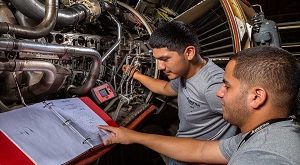Each part of the military gives exceptional vocation open doors. Professions in the Naval force frequently center around cruising and related obligations. Nonetheless, there are various different vocations fundamental for the Naval force’s tasks. In this article, we examine what a Naval force flight specialist is, what they do and how to become one.
A Naval force flying repairman guarantees the legitimate working of inside and outside airplane frameworks and supports flight tasks. This requires dealing with careful upkeep, reviews, fixes and substitution. They acquire the grouping code of flight primary technician (AM) to act as an aeronautics underlying repairman halfway level or avionics underlying specialist hierarchical level.
Naval force flying mechanics might deal with different obligations. For instance, some act as flight engineers on certain kinds of airplane. Others might elect to fly as a feature of the Maritime aircrew. They might finish a scope of in-flight obligations and work airplane frameworks on board propeller airplane, helicopters and turbojets.
It’s important for Navy aviation mechanics to possess and develop skills like:
Mechanical skills
Technical skills
Attention to detail
Manual dexterity
Ability to work closely with others
Ability to work with little supervision
Ability to completely physical work
- Naval force aeronautics mechanics might serve adrift or ashore, and many split their time equally between the two. A technician might work inside in shelters or storage decks or outside on flight decks or flight lines at air stations. Functioning as a Naval force flight technician might include working impermanent obligation tasks, requiring extra travel.
What does a Navy aviation mechanic do?
- Naval force flying mechanics handle different undertakings. Their obligations might include:Keeping a scope of airplane related frameworks and parts, for example, landing gear frameworks, brakes, pneumatic frameworks, controllers, siphons, chambers, fittings, lines, siphons, crisis inciting gadgets and repository compression
Adjusting parts like expert brake chambers, oleo swaggers, pressure gatherers, repositories and crisis air bottles
Examining, eliminating and supplanting pressure driven framework parts
Supplanting water driven parts like gaskets, wipers and pressing
Eliminating, fixing and supplanting wings, airfoils, haggles, airplane fuselages, fixed and portable surfaces, controls, systems and standard seats
Eliminating, introducing and fixing airplane flight control surfaces
Creating and collecting metal parts
Finishing minor fixes on airplane skins
Introducing metal clasp and bolts
Painting and welding different parts
Manufacturing fixes for composite parts
Performing non-disastrous color penetrant assessments
Performing different airplane reviews, for example, preflight, postflight and other everyday assessments
Dealing with dangerous weapons installed different airplane
Furnishing the Naval force Armada with assault, guard and calculated helpComplete the basic education requirements
- It is necessary to have at least a high school degree in order to join the Navy. Candidates with a GED or other comparable education may be accepted by the Navy, but they may need to meet additional standards in order to enroll. When in high school, pay particular attention to courses offered in:Math Communication in English
topics pertaining to trade
auto maintenance
Technology Talk to a recruiter
- Converse with a selection representative about your longing to enlist in the military. Your selection representative can assist you with diving more deeply into the different military branches and the different positions inside them. They might give you direction with respect to your subsequent stages, including whether procuring a higher education before you enroll may help you. Enrollment specialists additionally give understanding in regards to the enrolling system, different prerequisites and what’s in store during preparing and military life.
Consider procuring a higher education
Turning into a Naval force flying repairman doesn’t need procuring a higher education. Nonetheless, you might decide to seek after a degree to assist with setting you up for your ideal occupation. The Naval force suggests different partner or four year college educations connected with the obligations of a flight repairman.To procure a partner’s certificate, consider picking a degree or program like:AA partner of artistic expressions in law enforcement
AS expert flight
AS specialized examinations in electromechanical advancements
AAS aeronautics support
AAS business organization in administration
AAS equity concentrates on in law enforcement
AAS specialized examinations in electromechanical advances
It’s memorable’s critical some progression open doors in the Naval force might expect you to have a four-year degree or favor up-and-comers who truly do have one. For instance, turning into a flight support obligation official requires a four-year degree. To procure a four year certification, consider picking a degree or program like:BA hierarchical turn of events
BS business organization
BS equity concentrates on in law enforcement
BS proficient aviation
BS specialized administration
BBA business organization in everyday business
BBA business organization in administration
BBA business organization in advertising

